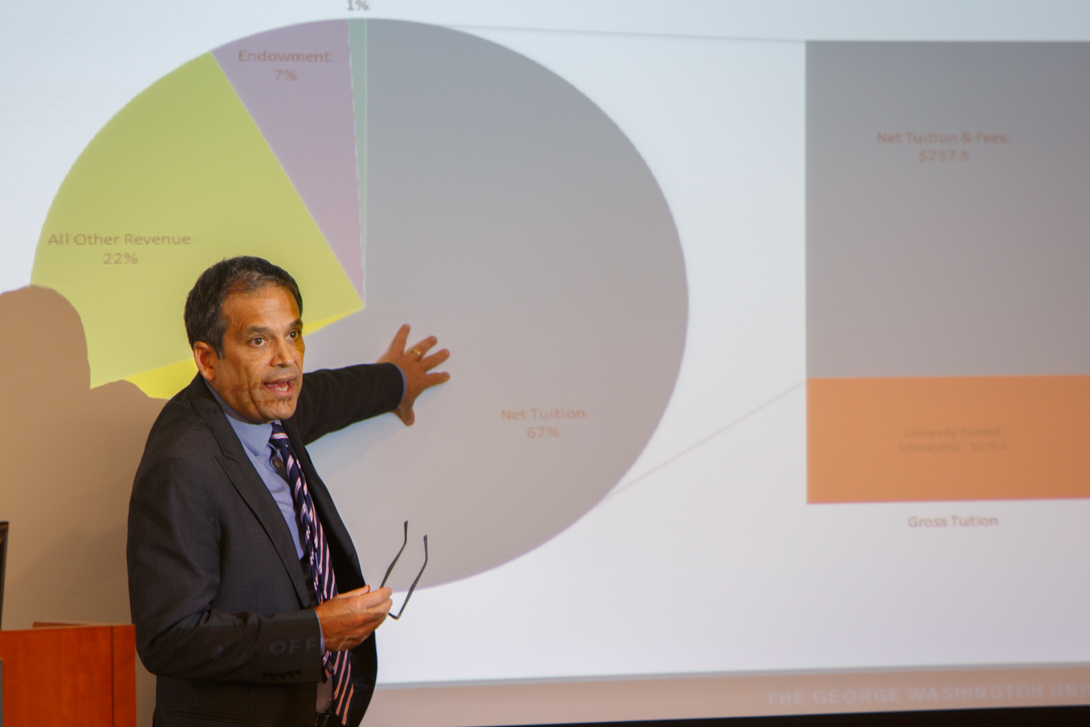Provost Forrest Maltzman explained George Washington University’s new budget model at the Faculty Senate meeting Friday, saying the new process is an alternative way to distribute resources to the university’s seven “open schools.”
Under the new model, the open schools—Columbian College of Arts and Sciences, College of Professional Studies, Elliott School of International Affairs, Graduate School of Education and Human Development, School of Business, School of Engineering and Applied Science and the School of Nursing—each receive $320 per undergraduate student credit hour in fiscal year 2017.
For graduate students, each school will retain a percentage of tuition paid: 70 percent if the graduate class is taught on campus, 80 percent if the class is taught off campus and 85 percent if the class is taught online.
(GW’s “closed schools”—GW Law, the School of Medicine and Health Sciences and the Milken Institute School of Public Health—are self-funded.)
Last year was the first that the new budget process was used, Dr. Maltzman said. Plans are to monitor the new model over three years, see how it works and make changes as necessary.
“There is no budget process that exists that meets every single goal for every single department,” Dr. Maltzman said. “There will always need to be some sort of regulatory controls to catch loopholes. These [budget] models will and do inevitably evolve over time.”
Under the old budget model, he said, the provost and each school dean would agree annually on a projected student enrollment. If the school met the projection for undergraduate and graduate enrollment, it would receive the approved funds. If actual enrollment exceeded the enrollment projection, the school would get the approved funds plus a one-time 40 percent of the extra tuition revenue.
If the schools failed to meet their enrollment projections because students transferred internally or to other universities or because entering classes were smaller than projected, the schools were responsible for 100 percent of the shortfall.
The old budget model was not always a good experience for students, Dr. Maltzman said, because schools sometimes “dragged their feet” during the transfer process if that helped the school meet its enrollment projections.
“We actually do want students switching around” from school to school, he said.
Sometimes under the old model, Dr. Maltzman said, deans would low-ball enrollment projections. “And then they would—surprise—exceed it,” he said.
“Deans didn’t like it…,” he continued, “and it didn’t work best for students.”
Members of the senate raised questions about how schools are compensated for similar line-items that are more expensive in some schools, why the new budget model calls for 3 percent compensation increases and whether the new model provides deans with incentives to handle their budgets better.
Dr. Maltzman said that, for example, it costs more to hire faculty in the School of Business than in the Political Science department and that central administration meets those cost differences with adjustments.
“This past year, every one of our schools ended up in the black,” Dr. Maltzman said.
George Washington President Steven Knapp said the new budget model was developed for a “very simple” reason. “The deans were having trouble understanding the old model,” Dr. Knapp said. “I had the experience myself while trying to help a dean, and the treasurer’s office couldn’t help. We needed a new system.”
During general business remarks, Dr. Maltzman said that the university was at 99.66 percent of the enrollment cap set by the District government for the Foggy Bottom Campus. He also noted that District House is now open with a student-run food pantry for GW students who might be suffering from food insecurity.
“That’s a great example of students helping students,” Dr. Maltzman said.
Dr. Knapp mentioned that Friday marked the beginning of Colonials Weekend, noting how he is “increasingly seeing families that want to be involved in the university.
“This is different from when I first started” as president, Dr. Knapp said.
The president also mentioned two recent additions to Vice Provost for Enrollment Management and Retention Laurie Koehler’s team in Enrollment and Retention: Costas Solomou, undergraduate dean of admissions, and Oliver Street, director of enrollment retention.
And Dr. Knapp noted that for the first three months of this fiscal year, GW received $88 million in research grants, an increase of 135 percent over the same time last year.
In other business, the Faculty Senate voted to table nominations of five new members to the Benefits Advisory Committee, the standing group of faculty and staff charged with providing ongoing feedback to University Human Resources and Benefits Administration. Members of the Faculty Senate wanted more discussion on whether the nominations were representative of the faculty and GW’s schools.


